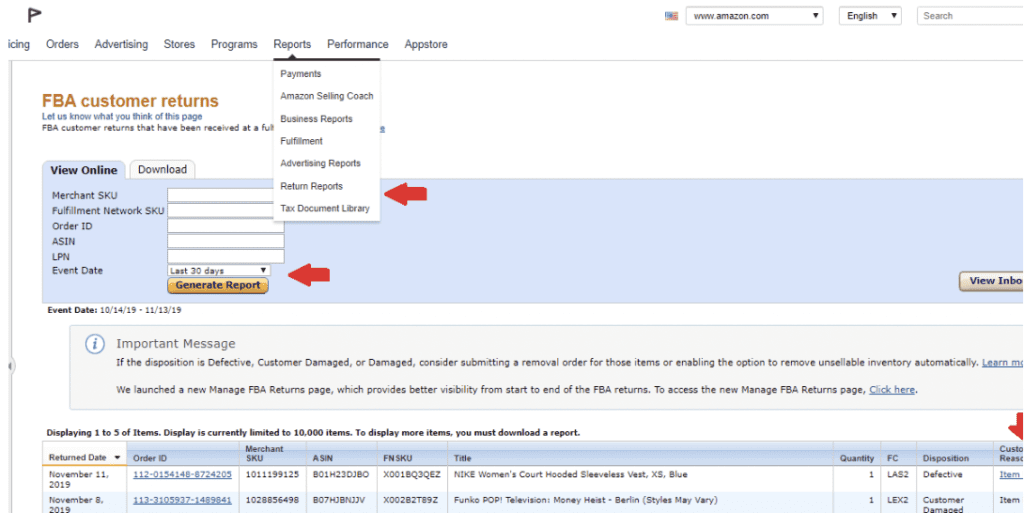While product returns are part and parcel of any ecommerce business, they can pose a significant challenge for Amazon FBA sellers. This is particularly due to the potential fees associated with the return process. However, with the right strategies in place, it’s possible to minimize both the occurrence of product returns and the fees related to them.
Understanding Amazon’s FBA returns policy is the first step in effectively managing product returns. In general, Amazon provides a comprehensive return service for FBA sellers. Yet, the more complex your inventory, the more challenging it can be to navigate this process without incurring additional costs. Luckily, there are ways to mitigate these potential pitfalls.
To begin with, a clear comprehension of what makes your product returnable is vital. Amazon typically allows customers to return items within 30 days of receipt. However, it’s crucial to keep in mind that a product’s categorization can influence its eligibility for return, thus influencing your potential fees.
Once a customer initiates a return request, Amazon handles it on behalf of the FBA seller. However, you need to monitor the process to ensure that Amazon correctly interpreted your product’s eligibility for return. Regular checks on your Returns report can provide valuable insights into any recurring issues and offer an opportunity to resolve them promptly.
In addition, accurate product listings can decrease return rates. Ensure you provide as much detail as possible about the product’s dimensions, functionalities, and usage. High-quality product images and videos can help too. A careful description helps meet customer expectations and reduces the likelihood of product returns.
Customer feedback is another crucial aspect that can shed light on recurring patterns in product returns. Regularly reviewing customer reviews and ratings can reveal issues that you may need to address. This could help identify problematic product features, poor shipment handling, or inaccurate product descriptions that lead to dissatisfaction among customers.

Consider partnering with professional FBA account management services to help you manage the return process. These services can assist you in understanding Amazon’s FBA policies and identifying how you can minimize return-related fees. Investing in such services could positively impact your bottom line in the long run by reducing overhead costs.
Addressing product quality issues promptly is paramount. Have strategies in place to sort out defective goods once they’re returned, and take immediate action to avoid similar issues with future batches. While this might not directly minimize the return fees, it can significantly reduce the number of returns, which indirectly would lead to savings.
For products that often experience high return rates, consider alternative fulfillment options outside of FBA. Self-fulfilling these products may decrease costs associated with returns. However, this strategy should be balanced with the additional time and resources that would be needed for self-fulfillment.
In case of damaged or lost items, Amazon provides FBA reimbursements. Therefore, always check that the returned items are in the correct condition based on the reason for the return. If there’s a discrepancy, you can apply for a reimbursement from Amazon, thereby decreasing your losses.
Leveraging product return data can also be beneficial. Patterns may emerge that point to particular products or categories experiencing higher return rates. Concentrated efforts can then be put into these areas to reduce future return instances and associated fees.
Learning to understand Amazon FBA return reasons can be an influential factor in minimizing fees as well. Figuring out why customers are returning products could potentially help in reducing product returns altogether. Is the product not as described, or is it arriving damaged? Understanding the reasons can guide your measures effectively.

Appealing certain disposal and removal orders can result in savings for FBA sellers. Amazon does make mistakes and can incorrectly classify your product. By regularly reviewing your Inventory Health report, you can spot potential errors and quickly address them.
Considering the importance of customer loyalty and satisfaction, be sure to handle returns with grace. It’s crucial to maintain open, respectful communication with buyers during the return process. A focus on excellent customer service can prevent negative reviews, maintain customer loyalty, and ultimately contribute to the objective of reducing returns.
In summary, a strategic approach to handling Amazon FBA product returns can end in significant cost savings for online sellers. From understanding Amazon’s policies to making use of data insights and feedback, sellers can proactively work to reduce returns and associated fees. A well-thought-out returns management strategy can pave the way for a more profitable and sustainable ecommerce business.


